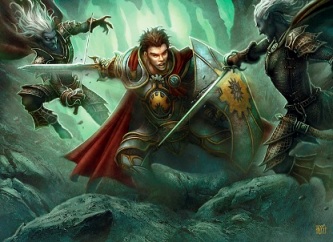
This is part of a series of articles surrounding character death in D&D 4th edition. For related articles, go here.
![]() Dealing with character death shouldn’t stall or end a game or story, especially if you’ve already planned for it as a playgroup. As you and I both know, adventuring is dangerous – heroes die, even in 4e. Here are some ways to be ready for it and manage character death smoothly in your campaign, whether you DM or play:
Dealing with character death shouldn’t stall or end a game or story, especially if you’ve already planned for it as a playgroup. As you and I both know, adventuring is dangerous – heroes die, even in 4e. Here are some ways to be ready for it and manage character death smoothly in your campaign, whether you DM or play:
- Character Death Expectations & Table Rules: At campaign (or adventure) start, share your attitudes about character death with your playgroup. Remind them, as per the core rules and DM’s Book, most monsters finish off dying heroes – but some certainly will. Good questions to ask: How gritty and realistic are monsters and their motivations when it comes to finishing off enemies? Which monsters will go for the kill and how often? Zombies, ghouls, ankhegs, kruthiks, drow, mindflayers? Serial killers, madmen, merciless villains? Is it something to be expected occasionally, depending on the situation and given adversary? How fair and “by the dice” is your DM’s playstyle? Does he or she pull punches or let the dice fall where they may? Another point to remember is there’s a reason that epic destinies often include character death-triggered powers – character death is expected in D&D, especially at high levels of play!
- Storytelling Opportunities: Talk about how character death doesn’t mean the story, adventure or game stalls or end – on the contrary, like a skill challenge, it’s only a minor setback and the show must go on. And, it can even be fun! Remind everyone how cinematic, dramatic and compelling character death scenes and reactions to that character’s death scene can and should be. This is a great opportunity for heartfelt roleplay over a brave, fallen comrade. Discuss possible bonus roleplaying XP awards, or other unique awards based on the scene and any inspired, collaborative roleplay. Also discuss and encourage creative ways to “come back from the dead” – such as unique scenes with a pious character’s deity or an exarch, a return to the world as a revenant in the name of the Raven Queen, or some other unique story besides typical ritual magic such as raise dead. Encourage and talk about DM and PC collaboration when it comes to entwining chracter death with campaign story or world lore aspects. Let your creative minds collide and see where it goes!
- Save Your Gold for Raise Dead: Since heroic adventurers risk life and limb slaying monsters and fighting ever-present wickedness and evil in a dark world, it’s important your party establishes a party fund to deal with such risks – at least, from the perspective of monetary cost, as money alone cannot remove scars to the body or mind. It is wise to keep some combination of gold or ritual components aside, even informally. One day soon enough, you’ll need them for the urgent and express purpose of ritual magic scrolls and books to combat disease, petrification and death.
- Character Tree & Backup Characters: A classic D&D approach to smoothly manage character death, the first incarnation of Dark Sun discussed the Character Tree – or, basically, having several backup characters. Perhaps yours all have some loose or strong connection to one another, making them each jump off their character sheets. Establish as a playgroup whether the old school approach of keeping at least one backup character online or with you at all times is required or at least strongly suggested. Great approach for especially gritty and deadly campaigns like Dark Sun, or for players who simply enjoy character creation and storytelling. The recently added Character Builder feature, a printable text-only character summary, is a great way to quickly print out and keep a backup character, either for every session, or on the spot, to play through the remainder of the game session.
- NPC Companion Characters: A simple and quick alternative in 4e to backup characters, have a player whose character just died take on full control of an NPC companion character. NPC Companion Characters often fill out small parties or serve as “supporting actors” in any size party for a certain amount of time, whether it’s just for an encounter or adventure, or even a whole tier of play or entire campaign. As per the DMG2 rules, players typically run the NPC Companion Character in combat, while the DM usually takes the lead on roleplay and banter. Once the player assumes full control of the companion character upon his or her PC’s death, the PC can decide to slowly add or change some personality quirks, and even recreate the companion character as a full PC for next session or longer depending on their preference and the story situation.
As you can see, there are a lot of options and opportunities when it comes to managing character death, from roleplay and story to being physically prepared to continue the grand story of your adventurers, whatever challenges or tragedy come their way. Your collective attitude about character death and your imaginations are the only limits. And along the journey into and past character death, make sure to tap into 4e’s rich digital tools and character options to help you – keep playing, above and beyond death!
[…] Fear of Death: How To Smoothly Manage Character Death […]